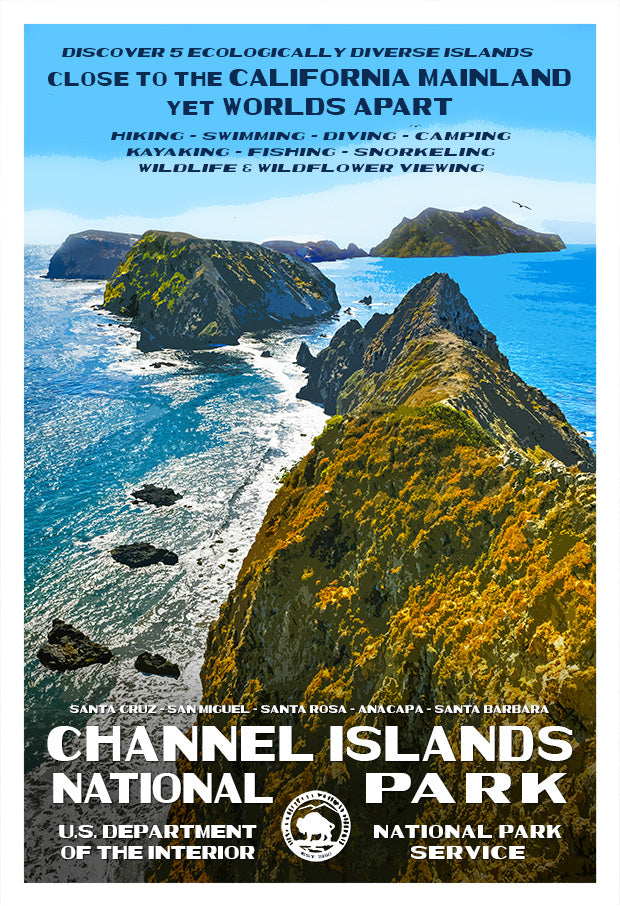
Channel Islands National Park – the Galapagos of North America
Robert DeckerEmbark on a journey to Channel Islands National Park, often hailed as the Galapagos of North America. Discover the unparalleled beauty, unique ecosystems, and rich biodiversity that make these islands a must-visit destination for nature enthusiasts and adventure seekers alike. Explore the wonders that lie in this less-traveled path, where the majestic landscapes and vibrant marine life promise an unforgettable experience.
My name is Rob Decker and I'm a photographer, graphic artist...and national park lover! I've been to 55 of America's national parks, as well as countless other national park service sites. So, if this is your first trip to Channel Islands, or you're a repeat visitor, read on to learn more about Channel Islands National Park!
Comprising five gorgeous islands along California’s Santa Barbara Channel, Channel Islands National Park enjoys a unique ocean environment. The islands of San Miguel, Santa Rosa, Santa Cruz, Anacapa, and Santa Barbara are shrouded in mist and close to the mainland but seem worlds away from the hustle and bustle of nearby Los Angeles.

Yellow Coreopsis & the Anacapa Lighthouse
Perhaps it is the more than 2,000 plant and animal species, of which 145 are found nowhere else on the planet, that makes these islands so special. The waters off-shore hold untold numbers of whales, dolphins, elephant seals, and some 30 other species of marine life. This abundance of wildlife and incredible scenery has given the national park the unofficial title of “The Galapagos of North America.”

Sea Lion Rookery, Santa Barbara Island

The Island Fox - It's found nowhere else on earth!
Each season at this island park brings something special to visitors as California’s mild weather allows the park to be open all year round. For spectacular views, Inspiration Point on Anacapa Island offers just that, while lounging sea lions can often be spotted on the rock formations of Cathedral Point. During the busy summer season, the blue whale (the largest animal on Earth) and humpback whales can regularly be spotted as they make their migration up north.
Due to its location, it is one of the least visited national parks in America. Access is only possible via a short ocean voyage or a small-plane commercial flight, and this light visitation has contributed to its remote feeling and the continued protection of fragile natural resources.
Protected by wind and waves, this is a place of solitude and adventure. Anacapa Island juts out of the sea with its craggy volcanic rock, holds an iconic lighthouse, and wildflowers that bring the rocky soil to life. Santa Cruz Island is the largest and most diverse of the islands and is home to 60 plants and animals found nowhere else. Santa Rosa island shelters rare Torrey pine trees, sandstone canyons, and contain vestiges of a ranching past.

Water Canyon Beach and Torrey Pines, Santa Rosa Island
San Miguel is an island of extremes. Its isolated beaches contain the largest rookeries of seals and sea lions on the planet. Fossilized trees from long ago dot the windy sand dunes. Lastly, the tiny island of Santa Barbara is a mesa framed by twin peaks and steep rock faces, where wildflowers and nesting birds remain untouched. All are surrounded by an underwater national park, one of the world’s great marine ecosystems.
A Bit of Channel Islands History
Much like the Galapagos chain of islands in South America, isolation of these islands has given evolution carte blanche to proceed independently, which accounts for the unique species that thrive here.

Dwarf Wooly Mammoth
Archeologists have discovered some of the oldest known human remains in North America here. They have also discovered the bones of dwarf wooly mammoths, which thrived on the island until the last Ice Age about 11,000 years ago – an incredible insight into coastal southern California as it once was. This area, in addition to about 148 historic village sites spread among the islands, is a true peek into the ancient past.
The native Chumash were one of the most advanced people of their time, flourishing for thousands of years. They developed a complex society where they traded with the mainland in plank canoes, using shell beads for currency. Then the Spaniards arrived in 1542, leading to a tragic end of their society as they were exposed to measles and smallpox, devastating their population. During the 1800s, the descendants of these proud people were moved to the mainland, where they still celebrate their ties to the islands today.
The protection of the Channel Islands was ensured when Congress made this a national park, an international biosphere reserve, and national marine sanctuary in 1980. It established long-term monitoring of ecological information gathering so that scientists could predict future conditions in order to continue its protection, including conservation and restoration programs.
Click here to see the Channel Islands National Park poster.
Rob Decker is a photographer and graphic artist with a single passion for our National Parks! Rob is on a journey to explore and photograph each of our national parks and to create WPA-style posters to celebrate the amazing landscapes, vibrant culture and rich history that embody America's Best Idea!
Join the growing community of 110k+ National Park enthusiasts to receive insider deals and updates.

